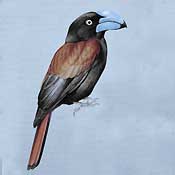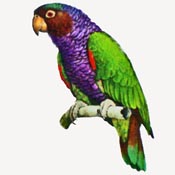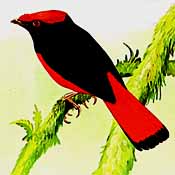| |
|
# |
Species [range] |
Photo/art [see credits];
all photos taken in the wild |
Summary of reasons for this choice |
DR seen? |
41 |
Ibisbill
Ibidorhyncha struthersii
[c. Asia] |
|
Breeding only along remote montane rocky streambeds in central Asia, this has been a highly prized species for birders for years. In its own family (Ibidorhynchidae), this adds to its allure. In the 1970s, the late Arnold Small, who had seen about 2/3 of the world's bird, stated this as the rarest bird he'd seen. It is now more accessible to birders in winter along rocky Himalayan foothill rivers in nw. & ne. India & Nepal. More recently, many birders have ventured into Bhutan, but it also breeds. |
Yes |
| 42 |
any Asian
ground-cuckoo
in genus
Carpococcyx
[tropical southeast Asia & Greater Sundas] |
 |
The 3 Carpococcyx species fill a similar niche as the Neotropical ground-cuckoos, but they are not inveterate ant-followerers. The two in the Greater Sundas are quite rare: Sumatran C. viridis and Bornean C. radiceus. The Coral-billed Ground-Cuckoo C. renauldi (shown) of southeast Asia is a bit more widespread and, with luck, a bit more 'findable' (e.g., Khai Yai NP, Thailand) but still, each is an incredibly impressive sight. |
No |
43 |
any
Neotropical
ground-cuckoo
in genus
Neomorphus
[tropical Central & South America] |
|
These impressive, near-mythical birds of the forest floor are most often seen with swarming ants; any of the five is a major highlight: Rufous-vented N. geoffroyi (shown), Scaled N. squamiger, Banded N. radiolosus (the rarest), Rufous-winged N. rufipennis, Red-billed Ground-Cuckoo N. pucheranii. Together they range from Honduras to Bolivia but all are difficult finds.
[ Lesser Ground-Cuckoo Morococcyx erythropygus is in a different genus, can be locally common, and is not a forest bird; it is not part of this set. ]
|
No |
| 44 |
Bali Myna
Leucopsar rothschildi
[Bali] |
|
"What's in a name?" Some call this "Bali Starling" but the word "starling" has negative connotations. I prefer Bali Myna. It is critically Endangered because it has an extremely small range and population. Initially, despite conservation intervention, the number of mature individuals continued to decline owing to illegal poaching. Only a dozen wild birds remained in 2000. Since then, captive breeding has been successful, and the myna has been reintroduced to Bali Barat NP, Bali. Numbers have grown to over 500 now in the wild.
|
Yes |
45 |
Hyacinth Macaw
Anodorhynchus hyacinthinus
[s. central South America] |
|
The largest of the wonderful "blue macaws" of South America is found in the Pantanal region of se. Brazil and adjacent Paraguay & Bolivia. The population has been seriously reduced by the illegal parrot trade. Two smaller relatives are even more endangered: Lear's Macaw A. leari of northeastern Brazil (only a couple known colonies left), and Spix's Macaw Cyanopsitta spixii of interior Brazil (the last one known to exist in the wild has disappeared). |
Yes |
46 |
Volgelkop Bowerbird
Amblyornis inornatus
[w. New Guinea] |
|
A Volgelkop Bowerbird isn't much to look but its creation is: the male builds the most fantastic bower of any bowerbird, spending most of its time working on the cone-shaped hut centered on a thick maypole, decorated with a foyer and 'lawn' of colorful artifacts. It is astonishing. The species is difficult to reach — restricted to the Arfak, Tamrau & Wandammen Mts in the Indonesia half of New Guinea — but the effort to get there can be rewarding. Many other bowerbirds are extraordinary, but this artist tops them all. |
Yes |
47 |
Orange-throated Tanager
Wetmorethraupis sterrhopteron
[Peru] |
|
Only discovered in 1964, it represents those "birds without a name" discovered by intrepid researchers [see Don Stap's (1991) A Parrot without a Name]. Wetmorethraupis is a monotypic genus; striking, colorful, and very local within a narrow altitudinal range (600-800m) in n. Peru & s. Ecuador. There are other fabulous tanagers, including the endangered Cherry-throated Nemosia rourei in n.e. Brazil, plus Multicolored Chlorochrysa nitidissima [see below], Glistening-green C. phoenicotis, abd Yellow-scarfed Iridosornis reinhardti in the Andes. |
No |
48 |
Araripe Manakin
Antilophia bokermanni
[Brazil] |
|
This is yet another choice that represents a larger group: any manakin is an exciting little bird. In many species the males form leks to display to females by wing-snapping, acrobatic jumping, and calls. This is not a lekking species, but this very striking manakin was discovered only in 1996 in the Chapada do Araripe of northeast Brazil, where it is considered critically endangered with a known range of only 1 sq.km. Fortunately that locale is within a protected area that can be visited. |
No |
49 |
Rail-babbler
Eupetes macrocerus
[Peninsula Asia, Sumatra, Borneo] |
|
Birds that walk on the forest floor are always exciting. The enigmatic Rail-babbler became even more interesting when molecular evidence showed it was not closely related to any other species, but was of a relict lineage and deserving of its own monotypic family. Finding one is difficult until one tracks its soft pitta-like whistle, and that can be tough in thick lowland jungle. |
Yes |
50 |
Great Gray Owl
Strix nebulosa
[North America, n. Eurasia] |
|
The largest owl on earth is all feathers. Other owls may be heavier but this is the huge gray ghost of the Holarctic north woods is always a great treat. I wanted one owl in the "top 50," and this is a very special bird. [I know an Australian who would have chosen Snowy Owl Bubo scandiacus]. Most of the big tropical owls are widespread but the world's smallest owl — Long-whiskered Owlet Xenoglaux loweryi of Peru — is rare, local, and would have been a good choice [luckily, I got to see it in 2015]. |
Yes |
|
| |
| |
THESE SPECIES |
JUST MISSED THE CUT (or dropped down as another took its spot) |
|
Helmet Vanga
Euryceros prevostii
[Madagascar] |
 |
Until the vangas were subsumed into a larger family, the former family Vangidae was found only on Madagascar. Among the most immpressive of endemics there is Helmet Vanga, restricted to forests in the far northeast that are still difficult to reach. It is so unusual that it was initially placed in its own family "Eurycerotidae." It is considered vulnerable as it relies entirely on primary forest, and numbers are small within even the core of its restricted range. |
No |
Crested Argus
Rheinardia ocellata
[southeast Asia] |
|
There is an assortment of wonderful and rare pheasants. This impressive species has a much more restricted range than Great Argus Argusianus argus, another great bird that had been on earlier versions of my "top 50" list but is now comparatively easy to see. Much of the range of Crested Argus is within Vietnam & Laos, countries that had been difficult to visit until recently. I've been down-grading pheasants over the years and now move this fine bird to 'also-ran' status but I would still love to see one. |
No |
Lyre-tailed Honeyguide
Melichneutes robustus
[c. Africa] |
|
A (perhaps) apocryphal story that I've heard is that John Cassin, the pioneering ornithologist in the Congo basin, never saw this species despite hearing it on many occasions. It is virtually impossible to see from inside the forest canopy as it make "bouncing-down-the-steps" display flights above the canopy, enhanced by booming notes from its remarkable tail; the sound can be heard for a mile. Not much to see when sitting but this little bird should be considered for the 'top 50' for the difficulty in finding on and its very impressive display! |
Yes |
Crested Ibis
Nipponia nippon
[China] |
|
Once widespread in northeast Asia (including Korea & Japan), this unique ibis was once on the edge of extinction. A small population exists in the Qinling Mts. of Shaanxi Province, China, and numbers are slowly increasing . An observer can now drive to a small village in which they roost and nest; they fly to rice-paddies during the day. Other rare Asian ibis that could qualify for top status include Giant Ibis Thaumatibis gigantea and White-shouldered Ibis Pseudibis davisoni — both occur in Cambodia. |
Yes |
Imperial Parrot
Amazona imperialis
[Dominica] |
 |
The largest and possibly most-endangered of all the big parrots in the Lesser Antilles, perhaps 300 survive on Dominica. It is difficult to find because (unlike other Amazona parrots) it does not form flocks and it is secretive. The other endangered parrots of the Lesser Antilles are also prizes: Red-necked Parrot A. arausiaca, also on Dominica; and St. Lucia Parrot A. versicolor and St. Vincent Parrot A. guildingii, on their namesake islands. Population sizes of each range from just about 300-900. |
Yes |
Carpentarian Grasswren
Amytornis dorotheae
[n. Australia] |
|
There are 10 Amytornis grasswrens in interior Australia. At one time Eyrean A. goyderi was thought a lost species, but as the deserts became accessible it proved to be reasonably numerous. No grasswren is really rare, but Carpentarian may be the hardest to find in sandstone well to the north. Black A. housei may be the remotest locale. Graeme Chapman's (1996) article in Wingspan (RAOU mag) Vol 6, No 1, has spectacular photos of all. They all are striking birds, shy and often very, very elusive. I want to see them all someday. |
No;
but 5 other grass-wrens
seen |
Kokako
Callaeas cinerea
[New Zealand] |
|
Only two endemic New Zealand Wattlebirds still exist. Saddleback Creadion carunculatus is doing reasonable well where reintroduced on predator-free offshore islets. Kokako still lives in native forests on North Island but was rare and hard to find. It has a behavior of 'bouncing' through tall trees like a forest squirrel, and has an incredible vocal repertoire. Rita & I hiked many miles in search of it in 1997, without success. It is now recovering on some offshore islets (Tiritiri Matangi) and is now much easier to see. |
Yes |
Multicolored Tanager
Chlorochrysa nitidissima
[w. Colombia
- w. Ecuador
] |
|
Two near-endemics to Colombia — both of them range into w. Ecuador — are perhaps the most beautiful of all tanagers: Glistening-green Tanager Chlorochrysa phoenicotis and this species. I recall the unworldly 'waxy' look of this gorgeous bird in the rich subtropical zone of the western slope of the western Andes. There are just so many great tanagers — but one has to prioritize them some how. |
Yes |
any Red-Cotinga
Phoenicircus sp.
[South America] |
 |
The two species — Black-necked Red Cotinga P. nigricollis (left) and Guianan Red-Cotinga P. carnifex — are very impressive lekking cotingas. Black-necked, in bright crimson and black, was virtually unknown until ~70 years ago, when a lek was discovered quite close to Exploronapo Camp, downstream of Iquitos, Peru. Black-necked ranges across the Amazonian Basin; the more obscure Guianan is in humid lowlands of northeastern South America. The displays of both species have only recently been studied, and both are very hard to find away from leks. |
Yes; 1 of 2 |
any
Crowned-Pigeon
Goura sp.
[New Guinea] |
|
The four large Crowned-Pigeons of New Guinea are each colorful, impressive, and (relatively) hard to see: Victoria G. victoria, Scheepmaker's G. scheepmakeri, Western G. cristata [shown left], and Sclater's G. sclateri. Mostly ground-dwelling, they have no obvious relatives and are unique among the pigeons in multiple respects. Any would be fine to see. |
No;
0 of 4 |
African River Martin
Pseudochelidon eurystomina
[c. Africa] |
|
Once a near-mythical swallow, African River Martin has now been found to breed on the Atlantic coast of Gabon and migrate along large rivers in the western Congo Basin. Still, it remains largely overlooked despite its unique behaviors and attributes. [Its Asian counterpart, White-eyed River Martin Eurochelidon sirintarae of Thailand, is even more enigmatic and may be extinct.] |
Yes |
| |
THIS SPECIES |
isqualified — no longer exists in the wild except by human assistance |
|
Kakapo
Strigops habroptilus
[New Zealand] |
|
It is very difficult to see the world's only flightless parrot. All remaining individuals were captured from 1980–1992 from two isolated populations and taken to four well-guarded offshore islets in hopes that semi-natural breeding would save the species from extinction. The plan is working but only researchers, and volunteers willing to work during a 2–week stay, might see this huge parrot.
NOTE: this flightless bird exists only tiny offshore islets, similar to being "in a zoo;" it seems best to exclude it on the Top 50 list |
No |
|
| |
CREDITS:
All the artworks are copyrighted by the artist (as detailed below) and are either used with permission or are posted here in reliance on the non-commercial "fair use" doctrine; all rights are reserved by the artist
- Ian Lewington painted the Helmet Vanga; from Handbook of the Birds of the World, Vol. 14 (Lynx Edicions)
- Jan Wilczur painted the Araripe Manakin; from Handbook of the Birds of the World, vol. 9 (Lynx Edicions)
- Richard Weatherly painted the Carpentarian Grasswren; from The Fairy-Wrens (1982) by Richard Schodde (Lansdowne Editions)
- Angels Jutglar painted the Imperial Parrot; from Threatened Birds of the World (2000) by Birdlife International (Lynx Edicions)
- J. C. Harrison painted the Crested Argus; from Pheasants of the World (1951) by Jean Delacour (Country Life)
- Walter Weber painted the Lyre-tailed Honeyguide; from The Honeyguides (1955) by Herbert Friedmann (U.S. Nat. Mus. Bull. 208)
- Martin Woodcock painted the Black-necked Red-Cotinga, from The Cotingas (1982) by David Snow (British Museum), and the Giant Pitta, from Pittas, Broadbills and Asities (1996) by Frank Lambert & Martin Woodcock
- Arthur Singer painted to Western Crowned-Pigeon; from The Birds of the World (1960)
- Derek Onley painted the Kakapo; from Field Guide to the Birds of New Zealand (1996) by Heather & Robertson (Viking)
All the photographs are copyrighted by the photographer (as detailed below) and are used with permission; all rights are reserved to the photographer
- Kevin J. Zimmer photographed the Rufous-vented Ground-Cuckoo (Panama)
- Dan Singer photographed the Coral-billed Ground-Cuckoo and Orange-throated Tanager (Peru)
- Don Roberson photographed the Ibisbill (India), Hyacinth Macaw (Brazil), Vogelkop Bowerbird (Papua, Indonesia), Bali Myna (Bali, Indonesia), and Great Gray Owl (Yosemite NP, CA, U.S.A.); and also the Crested Ibis (China), Kokako (New Zealand), and African River Martin (Gabon)
- Murray Lord photographed the Rail-babbler (Panti Forest, Malaysia)
- John Dunning photographed the Multicolored Tanager (Colombia), shown here from Plate 46 of his book Portraits of Tropical Birds (1970; photo of briefly-captured bird)
|
or the picks via links at right:
|
|
|
|
|


